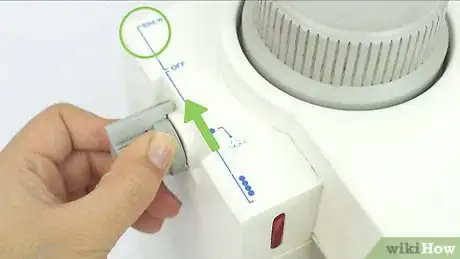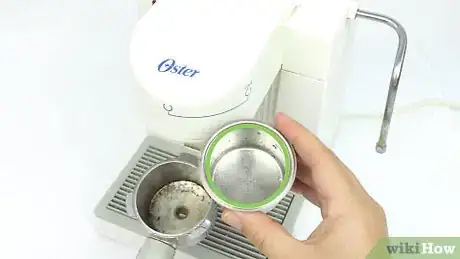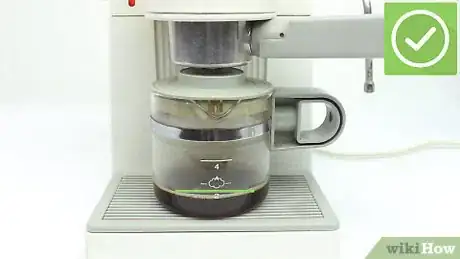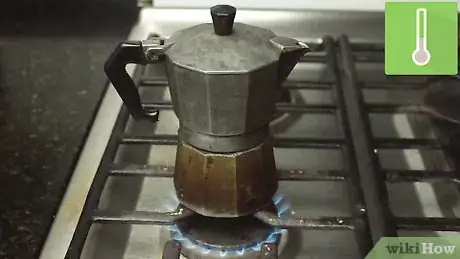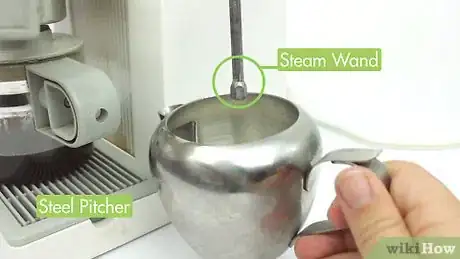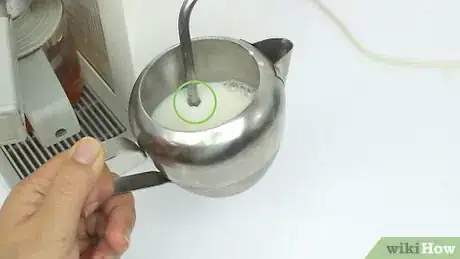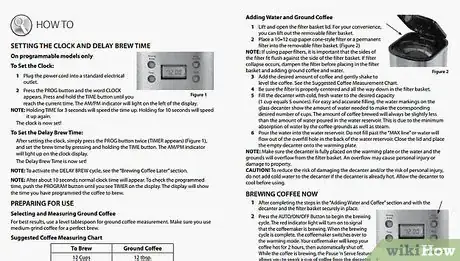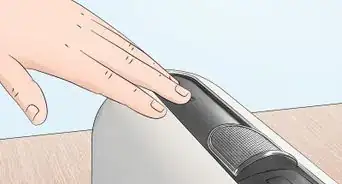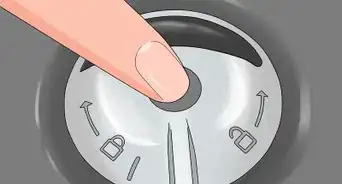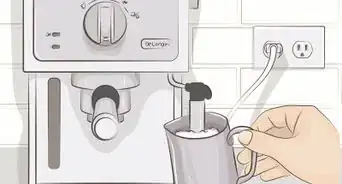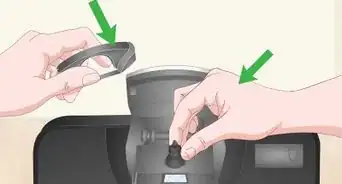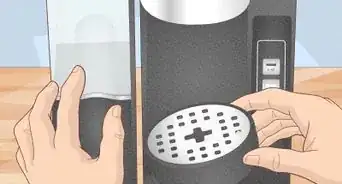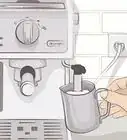This article was co-authored by Rich Lee. Rich is the Coffee & Food Program Director of Spro Coffee Lab in San Francisco, a California-based company that specializes in craft coffee, experimental mocktails, and culinary food science. Together with his team, Rich strives to bring forth a uniquely transcendent experience, free of stereotypical eats and drinks. Prior to owning his own business, Rich was a barista for big name coffee retailers such as Blue Bottle Coffee and Sightglass.
There are 11 references cited in this article, which can be found at the bottom of the page.
This article has been viewed 44,556 times.
Espresso makers are a great tool you can use to make a variety of delicious coffee drinks at home. Espresso makers come in stove top or machine varieties. Machine varieties are slightly easier to use, as they require less manual work. Most espresso makers are designed to be user friendly, so using them is a simple matter of filling the filters with coffee grounds and waiting for your espresso to brew. Make sure to clean your machine after each use.
Steps
Using an Espresso Machine
-
1Fill the reservoir. The reservoir is the part of the machine that holds water. There should be a clearly labeled reservoir on your machine, with lines indicating how far to fill it for a single or double shot.
- You can use filtered water if you prefer, but some espresso machines may have a built-in filter.
-
2Turn on the machine. Press your machine's "on" button, which should also be clearly labeled. You have to wait until a series of lights go on, indicating the machine is ready to use. Different machines indicate they're ready in different ways, so check your instruction manual.[1]EXPERT TIPRich is the Coffee & Food Program Director of Spro Coffee Lab in San Francisco, a California-based company that specializes in craft coffee, experimental mocktails, and culinary food science. Together with his team, Rich strives to bring forth a uniquely transcendent experience, free of stereotypical eats and drinks. Prior to owning his own business, Rich was a barista for big name coffee retailers such as Blue Bottle Coffee and Sightglass.Coffee & Food Program Director, Spro Coffee Lab

 Rich Lee
Rich Lee
Coffee & Food Program Director, Spro Coffee LabDid You Know? When you heat the water for your espresso, the ideal temperature setting should be between 195°-205°F.
Advertisement -
3Insert the shot basket. Remove the portable filter from under your machine's spout. The portable filter in an espresso machine is filled with a shot basket depending on the size espresso you want. Insert either a single or double shot basket into the portable filter.[2]
- If you use a double shot basket for a single shot, or vice versa, your espresso may not turn out. Before filling the basket, double check that you're using the right one.[3]
-
4Fill the filter with the coffee. Add your coffee grounds to the filter. Use a spoon to fill it just to the brim with the grounds. If any loose grounds got on the side of the filter, wipe them off with your fingers.[4]
- If you're grinding beans, most espresso machines have a built-in grinder you can use.
- If you have them on hand, use espresso grounds over coffee grounds. Espresso grounds are ground finer than coffee grounds. Espresso gets its layers and flavor from the fact hot water is forced through very small grounds.
- Using coffee within a few days generally helps it stay fresh and makes strong-tasting espresso.[5]
-
5Use your tamper. A tamper is a small device with a handle that you use to push down your coffee grounds. This helps ensure the grounds are compressed so you can make a strong-tasting shot of espresso. To use the tamper, press the top of the tamper on top of your grinds. Push downwards as far as the tamper will go to get your coffee grounds nice and compact.[6]
-
6Lock the filter onto the head. Push the head of the portable filter underneath the machine's spout. On most machines, you twist the filter slightly until you hear a clicking noise that indicates the filter is locked into the machine.[7]
-
7Place a cup under the faucet. Once the filter is locked in, place a cup just underneath the faucet's spout. Make sure the cup is big enough to contain your espresso.[8]
-
8Press the shot button. Espresso machines have buttons for either single or double shots. Press the button for the shot size you're using. The machine will now brew your espresso, and it will pour into your cup.[9]EXPERT TIP
If you have to press down the button manually to dispense water, hold it for about 35-40 seconds. That should dispense about 2 ounces.
Rich is the Coffee & Food Program Director of Spro Coffee Lab in San Francisco, a California-based company that specializes in craft coffee, experimental mocktails, and culinary food science. Together with his team, Rich strives to bring forth a uniquely transcendent experience, free of stereotypical eats and drinks. Prior to owning his own business, Rich was a barista for big name coffee retailers such as Blue Bottle Coffee and Sightglass.
Rich Lee
Coffee & Food Program Director, Spro Coffee Lab Rich Lee
Rich Lee
Coffee & Food Program Director, Spro Coffee Lab
Using a Stovetop Espresso Maker
-
1Fill the bottom chamber with water. A stovetop espresso machine has a top and bottom chamber. The bottom chamber should be filled just to the brim with cold water.[10]
- It's a good idea to quickly rinse the chamber first, just to make sure it's as clean as possible.
- For best results, use filtered water.
-
2Add coffee to the top chamber. Spoon your ground coffee into the top filter, filling it to the brim. Do not pack the coffee down. Instead, level it with your fingertips and wipe any excess coffee of the edges.[11]
- While you can use the same grounds you would use for drip coffee, your espresso may turn out better if you use espresso grounds. Espresso grounds are ground finer and espresso gets its layers and flavor from hot water being forced through very fine, tightly packed grounds.
-
3Secure the chambers together. Place the top chamber on top of the bottom chamber. Screw them together tightly so the chambers are completely sealed without any gaps.[12]
- You simply place the chambers on top of one another and twist, the same way you would twist the lid on a jar.
-
4Place the espresso maker on the stove. Place the espresso machine directly on the stove. It is not necessary to use a pot or pan. Turn the stove on to low heat.[13]
-
5Remove and serve your espresso. Times vary but check the espresso maker on occasion throughout the process. When the espresso is done, the top chamber will be filled with coffee. At this point, you can remove the espresso maker from the stove and pour yourself a cup.[14]
- It should not take more than five or ten minutes for the espresso to brew.
Making Espresso Drinks
-
1Invest in a steam wand and stainless steel pitcher. To froth and steam milk, you need a special device called a steam wand, which you can buy at a department store or online. A steam wand is used with a stainless steel pitcher. In most cases, the pitcher is filled about one-third of the way up with milk prior to the frothing or steaming process. To use the steam wand, you place the tip of the wand in the milk and then proceed to turn it on.[15]
- Some espresso machines come with a built-in steam wand that can be turned on using the machine's control panel.
-
2Froth milk with a steam wand. To froth milk with a steam wand, fill your stainless steel pitcher 1/3 of the way full with milk. Place the tip of the steam wand about half an inch (1.27 centimeters) into the milk, keeping it to one side of the pitcher. Turn the steam wand on and wait until the milk creates a natural whirlpool. Let the milk swirl until it doubles in size and has a nice, foamy texture.[16]
- If a whirlpool doesn't form on its own, swirl the pitcher clockwise slightly to create a whirlpool.
-
3Froth milk with a jar and a microwave. If you don't have a steam wand, you can use a jar and the microwave. Pour as much milk as you need in a jar. Screw on the lid tight and then shake the jar as hard as you can until the amount of milk has doubled in size. This usually takes between 30 and 60 seconds. After this, microwave the jar for 30 seconds so the foam rises to the top of the milk.[17]
-
4Steam milk with a steam wand. Fill your pitcher 1/3 of the way full with milk. Insert the steam wand far enough that its holes are submerged in the milk. Turn the wand on and wait for it to light up. Let go of the wand so it rests on the side and bottom of the glass. Once there is a steady whirlpool spinning, and the milk is lukewarm, tilt the pitcher at a slight angle. Let the milk heat until the pitcher begins to feel uncomfortable to touch.[18]
- Use your finger to measure the milk's warmth, but make sure to wash your hands first.
-
5Make a cappuccino. Place one to two shots of espresso in a cup. Pour steamed milk into the cup over the espresso to fill it an inch or two under the brim. Then, add two to three centimeters (.7 to 1 inches) of frothed milk on top of the steamed milk.
- If you want, you can add a dash of a sweet spice like cinnamon or some cocoa powder on top of your cappuccino.
-
6Make a latte. Make your espresso and pour it into a wide coffee mug. You can use either a single or double shot. Pour steamed milk on top of the espresso so it's filled an inch or two under the brim. Then, add about a finger's worth of frothed milk to the top.
Maintaining Your Machine
-
1Check your instruction manual before using your machine. Every espresso machine is different. It's always a good idea to read through your instructions before using your machine, just to make sure you're using it correctly.[19]
- If you lost your paper copy, you can do an internet search for your model of espresso machine. You may be able to find a PDF of the instructions online.
-
2Only use cold, clean water in the reservoir. Dirty water or warm water can break down your machine's reservoir. Make sure you're using clean tap or bottled water that's cool each time you brew espresso. If you're using tap water, it's a good idea to filter it for added cleanliness.[20]
-
3Clean your espresso machine after each use. Whether you're using a portable or electronic espresso maker, run the filters under the faucet to remove the grinds after each use. You should also wipe down the faucets and sides of the machine with a clean rag to remove any spills.[21]
Expert Q&A
Did you know you can get expert answers for this article?
Unlock expert answers by supporting wikiHow
-
QuestionHow much coffee do you put in an espresso maker?
 Rich LeeRich is the Coffee & Food Program Director of Spro Coffee Lab in San Francisco, a California-based company that specializes in craft coffee, experimental mocktails, and culinary food science. Together with his team, Rich strives to bring forth a uniquely transcendent experience, free of stereotypical eats and drinks. Prior to owning his own business, Rich was a barista for big name coffee retailers such as Blue Bottle Coffee and Sightglass.
Rich LeeRich is the Coffee & Food Program Director of Spro Coffee Lab in San Francisco, a California-based company that specializes in craft coffee, experimental mocktails, and culinary food science. Together with his team, Rich strives to bring forth a uniquely transcendent experience, free of stereotypical eats and drinks. Prior to owning his own business, Rich was a barista for big name coffee retailers such as Blue Bottle Coffee and Sightglass.
Coffee & Food Program Director, Spro Coffee Lab
References
- ↑ https://www.youtube.com/watch?v=M01UaF7znT4&feature=youtu.be&t=10
- ↑ https://www.youtube.com/watch?v=M01UaF7znT4&feature=youtu.be&t=37
- ↑ http://www.thecoffeebrewers.com/newtomaesfew.html
- ↑ https://www.youtube.com/watch?v=M01UaF7znT4&feature=youtu.be&t=100
- ↑ http://www.thecoffeebrewers.com/newtomaesfew.html
- ↑ http://www.thecoffeebrewers.com/newtomaesfew.html
- ↑ https://www.youtube.com/watch?v=M01UaF7znT4&feature=youtu.be&t=130
- ↑ https://www.youtube.com/watch?v=M01UaF7znT4&feature=youtu.be&t=150
- ↑ https://www.youtube.com/watch?v=M01UaF7znT4&feature=youtu.be&t=150
- ↑ https://ineedcoffee.com/stovetop-espresso-brewing-tutorial/
- ↑ https://ineedcoffee.com/stovetop-espresso-brewing-tutorial/
- ↑ https://ineedcoffee.com/stovetop-espresso-brewing-tutorial/
- ↑ https://ineedcoffee.com/stovetop-espresso-brewing-tutorial/
- ↑ https://ineedcoffee.com/stovetop-espresso-brewing-tutorial/
- ↑ http://www.thecoffeebrewers.com/frandstmi.html
- ↑ http://www.thecoffeebrewers.com/frandstmi.html
- ↑ https://www.thekitchn.com/how-to-froth-milk-for-cappuccinos-in-the-microwave-cooking-lessons-from-the-kitchn-100716
- ↑ http://drinks.seriouseats.com/2012/04/coffee-technique-how-to-make-steamed-milk-for-cappuccino-at-home.html
- ↑ http://www.ebay.com/gds/How-to-Use-the-Mr-Coffee-Espresso-Maker-/10000000177771636/g.html
- ↑ http://www.ebay.com/gds/How-to-Use-the-Mr-Coffee-Espresso-Maker-/10000000177771636/g.html
- ↑ http://www.ebay.com/gds/How-to-Use-the-Mr-Coffee-Espresso-Maker-/10000000177771636/g.html
About This Article
To use an espresso maker, start by filling the reservoir with water. Next, remove the portable filter, which holds the shot basket, from under your machine’s spout. Use a spoon to fill the filter to the brim with espresso or coffee grounds, then use your tamper to push the grounds down for a strong-tasting espresso. Once everything is ready, lock the filter onto the head, place a cup under the faucet, and press the shot button for your drink! For tips on how to use a stovetop espresso maker, keep reading!
